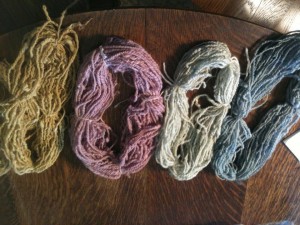
Once the skeins are prepared, you can begin dyeing. Many herbs can be used fresh or dried; however, fresh herbs will produce brighter colors, and you will probably enjoy them more. Harvest herbs early in the day, just after the dew has gone, for brightest colors. The flowers should be picked when just reaching full bloom. Roots are harvested in the fall, while leaves and barks are harvested in the spring. If you miss getting barks in the spring, those harvested in the fall will also make nice dyes.
Quantities
Experience is the only way to find the proper quantity of herbs for the colors you are trying to get (thus the reason for having a notebook handy to record your experiments).
- A general rule of thumb is one peck of plant matter for each pound of yarn to be dyed. When using nut hulls, wood, bark, or berries, use one pound, and with roots, use half a pound. It is always better to have more on hand than less, for you can always add to the pot.
- For each pound of yarn, you will need 4½ gallons of soft water.
Preparing the Bath
Chop the leaves, roots, or stems; separate the petals from flowers; or break up nut hulls, wood, and barks. Preparation varies from herb to herb, but these guidelines will get you started.
- Tough leaves, roots, hulls, and bark – Soak overnight in two gallons of water. The next day, strain the liquid and set it aside. Put plant matter in another two gallons of water. Bring it to a boil, then simmer for an hour (bark may take a little longer). Strain out plant material. Combine both quantities of water in pot for a dye bath.
- Flowers, fruit, and tender leaves – These are tender and damage easily, so they don’t require soaking. Place in four gallons soft water, bring to a boil, then simmer for thirty minutes to an hour (until it has given up its color). Strain out herbs.
Dying
- If your yarn is dry, soak it in lukewarm water for an hour before dyeing. Place skeins in a lukewarm dye bath; slowly raise the temperature to a simmer.
- Stir constantly with stirring rod for about an hour (half an hour for dye made from flowers, while dye from roots and barks may take two hours).
- Pull yarn from bath every few minutes to check color. Dyeing is done when you are satisfied with the color. Remember: colors will lighten as yarn dries.
- If the dye bath gets low while dyeing, pull out skeins and add water (the same temperature as the bath), return skeins, and finish dyeing.
Live Greener. Live Smarter. Live Better!
Record Keeping
Before knitting, weaving, or embroidering with your dyed yarns, record what you have done to achieve your end results. This is important due to the many variables that are possible when dyeing yarns. Testing and recording will allow you to successfully repeat a color you like well and also to bypass repeating the mistakes made while experimenting. While you may never get the exact colors every time, even when using the records to match what you did, with practice you will begin to gain a measure of control over your dyeing processes.
- Testing – how well your colors stand up in the light is an important quality of your dye. One way to test this is to hang yarn samples in a south-facing window and keep another set of samples covered in a notebook. After a month or two, compare the two and record the differences. Another way to test is to wrap a sample of yarn around a file card, keeping one half in direct sunlight and the other covered. As before, check for differences in a month or two and record the differences.
- Recording – This shouldn’t be saved until the last; instead, it should be done along the way as each step progresses. Take notes throughout all stages of the dyeing process, begin with gathering your herbs. In your dye notebook, record the herbs used, when and where gathered, amount of plant matter used, amount and type of mordant, quality of the water, etc. Also record the soaking time and simmering time of the plant materials in the dye bath and the time the yarn simmered. Note the results of your light tests, and finally, write in any remarks you find pertinent – pleasures, disappointments, surprises, etc. And beside each entry you may want to attach a yarn sample and add pictures of the garments and things created with your yarns.
Additional Resources
Dye Plants and Dyeing – A Handbook. New York: Brooklyn Botanic Garden, 1976.
Goodwin, Jill. A Dyer’s Manual. London: Pelham Books, 1983.
Grae, Ida. Nature’s Colors: Dyes From Plants. New York: Collier Books, 1979
Growing Herbs and Plants for Dyeing. Tarzana, CA: Select Books, 1977
Lesch, Alma. Vegetable Dyeing: 151 Color Recipes for Dyeing Yarns, Fabrics and Natural Materials. New York: Watson-Guptill Publications, 1970
Natural Plant Dyeing – A Handbook. New York: Brooklyn Botanic Garden, 1973
Robertson, Seonaid. Dyes From Plants. New York: Van Nostrand Reinhold, 1973
©2012 Off the Grid News